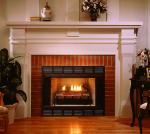Search engine visitors - click here to access entire "$ensible Home" web site
Click here to see a descriptive illustration showing several designs of vent-free fireplaces.
Related links - Fireplace Usage and Safety Tips
Dear Jim: I want to add a decorative fireplace with vent-free gas logs. The flames look realistic and it is simple to install myself. The salesman said they are 100 percent efficient. Is that true and are they safe? - Al M.

A: Vent-free gas fireplaces are nearly 100 percent efficient because there is no chimney to lose heat. This makes vent-free gas logs a relatively low-cost source of short-period supplemental heat for a room. With hand-held remote controls, they are convenient to operate from an easy chair.
For safe operation, the key is "short-period" usage. Burning vent-free gas logs uses about as much gas as cooking a big dinner on a gas range (not vented outdoors either). Vent-free gas logs are not intended for continuous heating as direct-vent gas or wood-burning fireplaces (with chimney) are.
With its open flame, there is little chance of carbon monoxide being formed if vent-free gas logs burn for a short time (check the manufacturer's recommendations for various room sizes). The concern is, as the oxygen percentage in the room air decreases, carbon monoxide may begin to form.
Since the 1980's, all vent-free gas appliances, except for kitchen ranges and ovens, include oxygen depletion sensors (ODS). If the oxygen level in the room begins to drop, the gas flow shuts off.
Some models include a catalytic converter, similar to an automobile, to create more complete, odor-free combustion. Other models also include carbon monoxide detectors, but you should still follow the manufacturer's usage guidelines.
Installing a vent-free gas fireplace is a simple job for the average do-it-yourselfer. Your local codes may require a plumber to attach the gas or propane line. Even if the codes don't, it is wise to hire a professional for the gas hookup. The rest of the job is a matter of assembling the kit.
Since the best flame pattern is a matter of personal taste, view several models to select the one you like. The decorative appearance of the fireplace surround and mantel are really the most important aesthetic factors. The percentage of time most families actually have a fire burning is small.
One of the most attractive vent-free fireplaces is a peninsula design. This provides three viewing surfaces and radiant heat in three direction. This is often used in a short divider wall between two rooms or in a larger room to provide for additional gathering area around the fireplace.
See-through models can provide heat and the ambiance of a fire for two rooms, but installing one will require more carpentry work. The standard single-sided model with an ornate wood surround is most common. It just rests against any wall and it should take only an hour or two to install one.
Instant Download Update Bulletin No. 725 - buyer's guide of 10 vent-free gas (natural gas, propane, alcohol-gel) fireplaces and log set manufacturers listing heat outputs, styles (bay, corner, single-sided, peninsula, see-through, six-sided), catalyst options, features, prices, illustrations, a sizing recommendation chart for each region of the country, and a cost-to-use chart.
Dear Jim: I am going to put new vinyl tile flooring down in a small bathroom. The heat duct ends just under the vanity and the heat works its way out a hole. Should this ducting be corrected? - Michael N.
A: The duct should continue through the floor to the opening under the vanity. This will direct more heat out into the bathroom making it more comfortable when stepping out of the shower on a cold morning.
It might sound like extra work to remove the vanity and extend the duct, but it also will make laying the new floor easier and result in a better-looking job. With the vanity out, you can run the vinyl under it instead of trying to fit the vinyl around it.